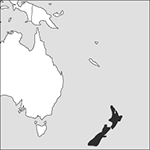
Source: MAPS IN MINUTES™ © RH Publications (1997)
Capital:
Wellington
Area:
267,710 sq km (103,363 sq miles)
Population:
4,365,113 (2013 est)
Currency:
1 New Zealand dollar = 100 cents
Religions:
Roman Catholic 11.6%; Anglican 10.8%; Presbyterian and Congregational 7.8%; other Christian 14.1%
Ethnic Groups:
European 71.2%; Maori 14.1%; Asian 11.3%; Pacific Island 7.6% (note: some people fall into more than one group)
Languages:
English, Maori, New Zealand Sign Language (all official)
International Organizations:
UN; Commonwealth; OECD; Pacific Islands Forum; Secretariat of the Pacific Community; Colombo Plan; WTO
A country situated over 1900 km (1180 miles) south-east of Australia, comprising the North Island and the South Island together with many smaller islands in the south-west Pacific Ocean.
Physical
The two main islands, separated by the fairly narrow Cook Strait, together stretch north-east to south-west over a distance of some 1600 km (1000 miles).
Economy
New Zealand’s once mainly agrarian economy was affected by the loss of preferential treatment by the UK, then the chief trading partner, when the UK joined the EC in 1973. Since then the economy has diversified, although agriculture is still important: major exports include dairy products, meat, and fish, and food processing is an important industry. Major export industries include wood and wood products and machinery, with other industries including textiles, transport equipment, financial services, and tourism.
History
First peopled by the Polynesian Maori from about 800 ad, European contact began in 1642 with the exploration of the Dutch navigator Abel Tasman. Captain James Cook, in successive explorations from 1769, thoroughly charted the islands, and brought them within the British ambit. Commercial colonization began from New South Wales in Australia and from the New Zealand Association (later Company) (1837) of E. G. Wakefield. Humanitarian pressures contributed to the decision formally to annexe the islands as the colony of New Zealand in 1840 on the basis that the rule of law was necessary to regulate Maori-settler relations (Treaty of Waitangi). In 1846 the British government conferred a limited constitution (rescinded in 1848) on New Zealand, divided into the provinces of New Munster and New Ulster, and in 1852 granted the islands representative government. Responsible self-government came in 1856. Settlement of the South Island prospered, assisted by the gold rushes of the 1860s. In the North Island, following the rapid acquisition of Maori land by settlers and by the government, the population was drawn into the disastrous Anglo-Maori Wars, following which most Maori land was settled. Regulations of 1881 restricted the influx of Asians, who were resented as a threat to the ethnic purity of the New Zealand people. They were confirmed by the Immigration Restriction Act (1920), whose terms were gradually liberalized. The property qualification for voting was abolished and women were enfranchised in 1893. In 1931 New Zealand became an independent dominion, although it did not choose to ratify the Statute of Westminster formally until 1947. In 1891–1911 (under the Liberal-Labour Party) and 1935–47 (under Labour) New Zealand won a world reputation for state socialist experiment, providing comprehensive welfare and education services. New Zealand actively supported the Allies in both World Wars, enjoying political stability and a high standard of living. After World War II it concentrated its defence policy on the Pacific and Far East, participating in ANZUS (1951–86) and sending a military force to Vietnam. Following British accession to the European Community (1973), New Zealand strengthened its trading links with Australia and its Pacific neighbours. When the Labour Party returned to power in 1984 it adopted a non-nuclear policy leading to withdrawal from ANZUS. The National Party under Jim Bolger won the election of 1990 at a time of economic recession. It confirmed Labour’s non-nuclear stance, but introduced stringent social welfare cuts, ending free state education and introducing health charges for all. The National Party was re-elected in 1993 and 1996 but lost its majority and Bolger formed coalition governments; Bolger resigned in 1997 and was succeeded by Jenny Shipley. Maori activists continued to demand compensation for land seized illegally by European settlers and the government agreed to pay compensation to the Waikato tribe in 1994 and to the Tainui tribal federation in 1995; in 1996 large tracts of South Island were granted to the Ngai Tahu tribe. In the 2000s Maori claims to own New Zealand’s foreshore and seabed became a political issue. In 1999, 2002, and 2005 Labour-led coalition governments were elected with Helen Clark as Prime Minister; these were followed by National Party-led coalitions under John Key in 2008, 2011, and 2014. In 2010 and 2011 two earthquakes on the South Island caused extensive damage in Christchurch. Key resigned as Prime Minister in 2016, and was replaced by Bill English, ahead of elections in September 2017. Although the National Party emerged as the largest party, it was unable to form a coalition and a Labour-led government took office under Jacinda Ardern.
- binary PSK
- binary pulsar
- binary regression
- binary relation
- binary representation
- binary scaler
- binary search algorithm
- binary search tree
- binary sequence
- binary signal
- binary space-partitioning tree
- binary star
- binary stars
- binary symmetric channel
- binary synchronous communications
- binary system
- binary tree
- binary-tree representation
- binary variable
- binary word
- BIND
- bind
- binder
- bindin
- binding